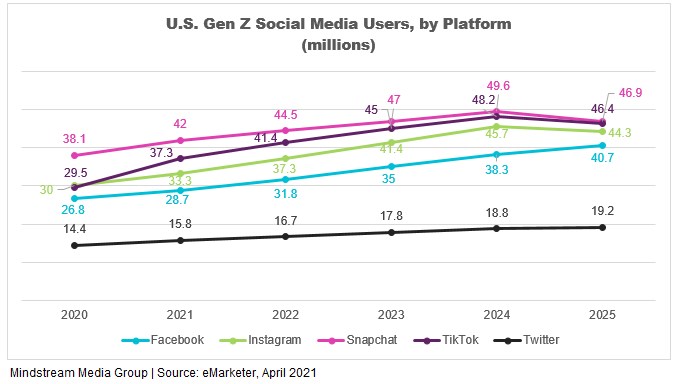
Ask any parent and they’ll tell you, teens are almost always on their phones. According to Common Sense Media, 78 percent of teens check their devices at least once an hour. The question marketers need to be asking is, “What are teens doing while on their phones?”
To try to figure that out, let’s look at the basic usage numbers and the primary things teens are using their phones for.
(A quick clarification: Some reports call teens Gen Z. Some refer to them as teens. For clarity in this article, we will use the term “teens” for anyone ages 12 to 17.)
Smartphone adoption
The latest report from eMarketer estimates that 86.5 percent of U.S. teens will use a smartphone this year. That’s comparable to the overall adult population, which is estimated at 74 percent; and slightly less than 18-24-year-olds, who are at 97.4 percent, due in part to the tendency for younger teens to not have smartphones yet.
Basically, the older the teen, the more likely they are to have, and regularly be on, a smartphone. They’re using social media, apps, games and messaging services. And, important for marketers, they have buying power. From games to clothes to electronics, teens are buying (or getting their parents to buy) a lot of stuff. Here are some tips to get them to pay attention to your advertising and buy your products and services.
Social media usage
TikTok has seen explosive growth in the last year and has become a serious competitor among social media platforms in terms of both usage and time spent. In fact, it has now surpassed Facebook in time spent among users and by the end of the year will have more Gen Z users in the U.S. than Instagram. This shows the rise in popularity of short video that’s well suited to a short attention span and can be consumed quickly and easily.
TikTok is closing the gap on Snapchat too, however, Snapchat is predicted to remain the leading social network among U.S. teens for at least the next four years.
Social media advertising
Although teens dislike advertising, YouGov data shows that 39 percent of American youth say advertising on platforms such as TikTok and Instagram grabs their attention.
Thanks in part to its less intrusive nature, influencer marketing has become a particularly impactful way to reach teens. By incorporating brand, product and service messages into the social content teens consume, influencer marketing provides a less disruptive advertising experience that resonates with teens. In fact, 70 percent of teens trust influencers more than celebrities and 6 out of 10 teens follow their advice.
Although they’re not yet old enough to vote, marketers shouldn’t doubt the online buying power of teens. An estimated 85 percent of Gen Z uses social media to learn about new products. They’re also shopping. An eMarketer May 2021 report shows that 62.8 percent of 14–17-year-olds have made at least one purchase via a digital channel (including mobile, online and tablet).
What’s next?
The data tells us that teens tend to switch their online habits. A lot. The social media platform that is No. 1 today may not be six months from now. They adapt to new technologies and trends and aren’t loyal to any one site. As marketers, we need to continuously monitor where teens are spending their time online and how they prefer ads to be delivered to them. Just because there’s a hot new app, doesn’t mean an influx of ads on that app is going to sit well with teens that liked the feeling of being an early adopter of a new site. It also doesn’t mean the hot new app will have staying power. Keep your eyes on things that may be taking off, but don’t jump in before it’s proven itself.
If teens are your target demographic, be willing to test, to research and to adapt quickly. They’re always on the move so you need to be able to do the same.
Editor’s Note: This post was originally published in September 2017 and has been updated for freshness and accuracy.



